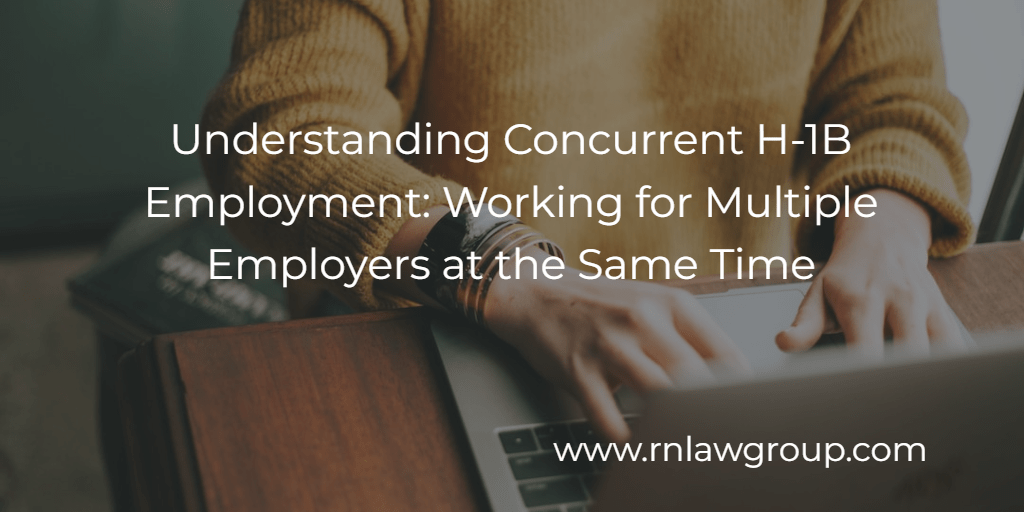
Understanding Concurrent H-1B Employment: Working for Multiple Employers at the Same Time
Concurrent H-1B employment allows H-1B visa holders to work for multiple employers at one time, which can offer multiple benefits to the H-1B worker. For example, it can provide H-1B workers with an increased level of job security (especially during times when company-wide layoffs are occurring), possible career growth opportunities, and the ability to work in multiple industries. It can also be beneficial in situations where the employer has adjusted work hours to part-time work. The process of concurrent H-1B employment can be confusing. Therefore, in this article, we will address the common questions received regarding concurrent H-1B employment.
1. How exactly does concurrent H-1B employment work?
If a foreign worker is in valid H-1B status with company A, company B can file for concurrent H-1B employment. Company B must go through the regular procedures when filing the H-1B petition. For example, Company B would obtain a certified Labor Condition Application (LCA) from the Department of Labor and file its own separate H-1B petition with USCIS. Company B would choose, “New concurrent employment” on Form I-129 as shown below.
Based on H-1B portability rules, the H-1B worker is allowed to begin work with the concurrent H-1B employer as soon as the H-1B petition is received by USCIS. If the H-1B petition for concurrent employment is denied, the H-1B worker would be required to stop working for company B, but may continue working for company A.
2. What are the requirements for concurrent H-1B employment?
The requirements for concurrent H-1B employment are no different than any other H-1B petition. Company B is still required to establish that a bona-fide employer-employee relationship exists, all wage requirements are met per the LCA, and the position is a specialty occupation, requiring at least a Bachelor’s degree in a field related to the position. The H-1B worker must also qualify to accept the job offer in the specialty occupation by:
- Demonstrating completion of a U.S. bachelor’s or higher degree required by the specific specialty occupation from an accredited college or university;
- Holding a foreign degree that is the equivalent to a U.S. bachelor’s or higher degree in the specialty occupation; or
- Having education, training, or progressively responsible experience in the specialty that is equivalent to the completion of such a degree.
Further, when applicable, the H-1B worker must provide an unrestricted state license, registration, or certification, authorizing the worker to fully practice the specialty occupation.
3. How many employers can an H-1B worker simultaneously work for?
There is not a set limit on how many employers an H-1B holder can work for based on concurrent employment. However, the H-1B worker will still be required to maintain H-1B status throughout employment. Therefore, H-1B workers should be realistic regarding how many hours per week they are required to work for each H-1B employer.
4. Can an H-1B worker work full-time for two employers based on concurrent employment?
There is not a set limit to the number of hours an H-1B holder can work per week. Therefore, an H-1B worker can technically have two full-time positions under concurrent employment. However, each H-1B petition will still have to be approved by USCIS. USCIS may deny the concurrent H-1B petition for full-time employment if it does not appear possible to work two full-time jobs. Therefore, where an H-1B holder is working full-time with company A, it may be more practical for company B to file for concurrent part-time employment.
Typically, full-time means 40 hours per week, unless the employer can demonstrate that less than 40 hours per week is full-time employment in its regular course of business. However, in no event would less than 35 hours per week be considered full-time employment.
5. Can an H-1B worker work part-time for two H-1B employers through concurrent employment?
Yes, an H-1B worker can hold two part-time positions under H-1B concurrent employment. Anything less than 35 hours per week is considered part-time employment.
6. Can an H-1B worker work remotely for multiple H-1B employers based on concurrent employment?
Yes, an H-1B worker can work remotely for multiple employers. The employer must ensure that the LCA and H-1B petition are properly filed to reflect the remote work location and that all LCA posting requirements are met.
7. When can an H-1B petition for concurrent employment be filed after an initial H-1B registration is selected in the lottery?
If an H-1B registration is selected in the lottery, the H-1B petition with Company A must be approved and the foreign worker must be granted H-1B status (beginning no earlier than October 1st of that fiscal year) before an H-1B petition with Company B can be filed for concurrent employment.
8. Can a foreign worker not selected in the H-1B lottery work for a cap-exempt employer and have a cap-subject employer file for concurrent employment?
Certain employers are considered exempt from the H-1B cap. These employers include (1) institutions of higher education, (2) non-profit entities related or affiliated with institutions of higher education, (3) non-profit research organizations, and (4) government research organizations. If a foreign worker secures employment with a cap-exempt employer, the foreign worker can thereafter have a cap-subject employer file for H-1B concurrent employment.
It is important to note that if employment with the cap-exempt employer ends, the H-1B worker will not be able to continue to work for the H-1B cap-subject employer without obtaining an approved H-1B petition through the normal H-1B cap process.
Conclusion
These are just a few common questions that arise regarding concurrent H-1B employment. The answers to these questions will depend on the specific circumstances of the foreign worker and the employer involved. Each situation is different and requires careful analysis to ensure the best outcome for each case. If you are an employer or H-1B worker who is contemplating concurrent H-1B employment and have questions, you can schedule a consultation with any of Reddy Neumann Brown PC’s qualified business immigration attorneys at Appointments.
Krystal Alanis is a Partner at Reddy Neumann Brown PC with over 10 years of experience practicing U.S. business immigration law. Krystal manages the firm’s PERM Labor Certification Department, where she oversees all EB-2 and EB-3 employment-based green card matters. Krystal guides clients from a variety of industries through the maze of the PERM Labor certification process and has handled thousands of PERM applications throughout her career. Krystal guides employers through the I-140 and Adjustment of Status process, and assists clients with temporary work visas. Further, she oversees the firm’s I-9 compliance team where she advises employers regarding Form I-9 Employment Eligibility Verification requirements and conducts internal audits of a company’s I-9 records, processes, and procedures. Additionally, Krystal represents clients in Form I-9 U.S. Immigration and Customs Enforcement (ICE) inspections (Notice of Inspection). Krystal successfully settled a claim with ICE over Form I-9 substantive paperwork violations that led to an 88% reduction in civil fines for her client.


